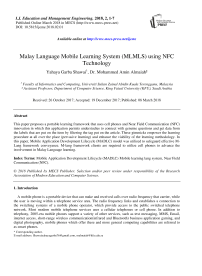Malay language mobile learning system (MLMLS) using NFC technology
Автор: Yahaya Garba Shawai, Mohammed Amin Almaiah
Журнал: International Journal of Education and Management Engineering @ijeme
Статья в выпуске: 2 vol.8, 2018 года.
Бесплатный доступ
This paper proposes a portable learning framework that uses cell phones and Near Field Communication (NFC) innovation in which this application permits understudies to connect with genuine questions and get data from the labels that are put on the item by filtering the tag put on the article. These gimmicks empower the learning procedure at all over the place (pervasive learning) and enhance the viability of the learning methodology. In this paper, Mobile Application Development Lifecycle (MADLC) model was utilized to safeguard effective M-Lang framework conveyance. M-lang framework clients are required to utilize cell phones to advance the involvement in Malay Language learning.
Mobile Application Development Lifecycle (MADLC) Mobile learning lang system, Near Field Communication (NFC)
Короткий адрес: https://sciup.org/15015756
IDR: 15015756 | DOI: 10.5815/ijeme.2018.02.01
Список литературы Malay language mobile learning system (MLMLS) using NFC technology
- Azadez Razaei,Neo Mai,Ahmad Pesaranghader. (2013). "Effectiveness of using English vocabulary mobile application in ESL's learning performance." International Conference on Informatics and Creative multimedia..Pg(114-118).
- Akinkuolie, Chai-Feng Len and Shyan-Ming Yuan (2012)."A cross-Platform mobile learning system using QT SDK Framework". 5th Internatonal Conference on Genetic and Evolutionary Computing
- Chen-Chung Chi, Chin-Hwa Kuo, Kuo-Yang Lin., (2012). "A design of mobile Application for English learning." 7th International Conference on Wireless,Mobile and Ubiquitous Technology in Education.
- Chen, Y.S., T.C. Kao, and J.P. Sheu. (2003). “A mobile learning system for scaffolding bird watching learning”. Journal of Computer Assisted Learning. 19( 3): Pp 255–398.
- David Tawei Ku, Chia-chi Chang. (2012). “Design and Development of Mobile English Learning Supporting System by Integrating RFID Technology for 4th grade Students”.Journal of Convergence Information Technology(JCIT). 7(7): Pp 538-541
- Demetrios G Sampson, Panagiotis Zervas.(2012).”Open access to mobile assisted language learning supported by the mobile2learn framework”.12th International Conference on Advanced Learning Technologies.Pg(441-445).
- Fisher, B., ed. Joyful learning in kindergarten. 1998, Portsmouth, NH: Heinemann.
- Heywood, P., Learning joyfully: An emotional and transformative experience. 2005.
- http://mindstorms.lego.com/en-us/Default.aspx. [cited 2012 20 July].
- http://www.nukotoys.com/. [cited 2012 20 July].
- Humez Korkmaz.(2010)”The Effective of Mobile Assisted Language Learning as a Supplementary Material for English Teaching Course Books”. Masters Thesis, Bilkent University.
- Jones, V. and J.H. Jo. (2004). “Ubiquitous learning environment: An adaptive teaching system using ubiquitous technology”, in Proceedings of the 21st ASCILITE (Australasian Society for Computers in Learning in Tertiary Education) Conference, R. Atkinson, et al., Editors: Perth, Australia: ASCILITE. Pp 468-474.
- Jukka Riekki, Marta Cortes, Marja Hytonen, Ivan Sanchez Riitta-Liisa Korkeamaki (2013)."Touching nametag with NFC phone; palyful approach to learning to read". Pp 228-242. Online book.
- Kostantinous Semetzidis.(2013). “Mobile Application Development to Enhanced Higher Education ”.Masters Thesis, University of NewYork.
- Ogata, H. and Y. Yano. (2004). “CLUE: Computer supported ubiquitous learning environment for language learning”. Transactions of Information Processing Society of Japan. 45(10): Pp 2354–2363.
- Ogata, H., R. Akamatsu, and Y. Yano. (2005). “TANGO: Computer supported vocabulary learning with RFID tags”. Journal of Japanese Society for Information and Systems in Education. 22(1): Pp 30-35.
- Vithani, T., and Kumar, A. (2014)."Modelling the mobile application development lifecycle".Proceeding of the International MultiConference of Engineers and Computer Science. Pp 1-5.
- Yahaya Garba Shawai, Noor Maizura Mohamad Noor, Mustafa Mamat, Zabidin Salleh.(2015). “Gumsa Framework for the Development of Mobile Learning System of a Malay Language using Near Field Communication”. Journal of Contemporary Engineering Science.8(14):Pp 623-640
- Almaiah, M. A., Jalil, M. A., & Man, M. (2016). Extending the TAM to examine the effects of quality features on mobile learning acceptance. Journal of Computers in Education, 3(4), 453-485.
- Almaiah, M. A., & Man, M. (2016). Empirical investigation to explore factors that achieve high quality of mobile learning system based on students’ perspectives. Engineering Science and Technology, an International Journal, 19(3), 1314-1320.


